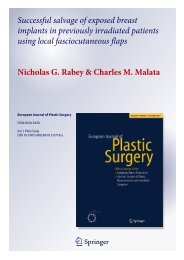Epigastric hernia following DIEP flap breast ... - ResearchGate
Epigastric hernia following DIEP flap breast ... - ResearchGate
Epigastric hernia following DIEP flap breast ... - ResearchGate
You also want an ePaper? Increase the reach of your titles
YUMPU automatically turns print PDFs into web optimized ePapers that Google loves.
390 K. Conroy, C.M. Malata<br />
Figure 4 A. Ms C epigastric <strong>hernia</strong> (right oblique). B. Ms C MRI showing a large epigastric <strong>hernia</strong>. C. Ms C post-repair of the<br />
epigastric <strong>hernia</strong>.<br />
Therefore, the possible mechanisms we propose for the<br />
formation of epigastric <strong>hernia</strong>s in patients with <strong>DIEP</strong> <strong>flap</strong>s<br />
are in summary:<br />
Laxity of the abdominal wall caused by partial denervation<br />
of the rectus muscles, repeated pregnancy, and<br />
obesity<br />
Transmitted pressure on the upper abdomen caused by<br />
tight plication of the infraumbilical rectus sheath<br />
Weakening of the abdominal wall caused by previous<br />
surgery<br />
Increased intra-abdominal pressure caused by lifting<br />
As all three patients had risk factors for the development<br />
of epigastric <strong>hernia</strong>s it could be argued that their presentation<br />
months after their <strong>DIEP</strong> <strong>flap</strong> harvest was merely coincidental.<br />
However, although epigastric <strong>hernia</strong>s are uncommon<br />
its proposed risk factors are common to many women,<br />
implicating the <strong>DIEP</strong> <strong>flap</strong> harvest as a predisposing factor.<br />
Specifically partial denervation of the rectus muscle by the<br />
lateral dissection 9 can lead to anterior abdominal wall laxity<br />
but this would be localised to the potentially denervated<br />
area, that is, well below the umbilicus, but none of these<br />
<strong>hernia</strong>s were located here. A more likely cause therefore is<br />
increased intra-abdominal pressure <strong>following</strong> the procedure;<br />
tight closure of the lower abdominal incision in the rectus<br />
abdominis muscle and sheath transmits an increase in pressure<br />
to the upper abdomen - which often remains un-plicated<br />
as this is unnecessary. A preexisting weakness (congenital or<br />
caused by pregnancy or heavy lifting) in the linea alba fascial<br />
structure may thus cause an epigastric <strong>hernia</strong>. Another<br />
possible mechanism is previous surgery as scar tissue in the<br />
anterior abdominal wall/sheath may have become stretched<br />
and weakened with pregnancies and the heavy lifting. This<br />
may act in combination with the first mechanism. Alternatively,<br />
these epigastric <strong>hernia</strong>s may have been present all<br />
along and <strong>DIEP</strong> <strong>flap</strong> harvest merely altered the abdominal<br />
contour, making them symptomatic e hence the<br />
presentation.<br />
Our report raises a number of questions. It would be<br />
interesting to look at the overall incidence of epigastric<br />
<strong>hernia</strong>s (symptomatic or not) after <strong>DIEP</strong> <strong>flap</strong>s in a larger<br />
group of patients. These were the only three cases out of<br />
113 patients receiving <strong>DIEP</strong> <strong>flap</strong> <strong>breast</strong> reconstructions<br />
performed by a single surgeon in preceding five years<br />
(January 2005eDecember 2009), and also after other forms<br />
of abdominal surgery. It is also unclear what the incidence<br />
of asymptomatic epigastric <strong>hernia</strong>s is. A larger study may<br />
help to distinguish whether epigastric <strong>hernia</strong>s are<br />
a complication of <strong>DIEP</strong> <strong>flap</strong> reconstruction, or whether they<br />
were merely coincidental. It may also shed some light on<br />
the aetiology of epigastric <strong>hernia</strong>s in general.<br />
Conclusion<br />
An interesting series of three symptomatic <strong>hernia</strong>s<br />
<strong>following</strong> <strong>DIEP</strong> <strong>flap</strong> <strong>breast</strong> reconstruction is presented. It is<br />
noteworthy that it documents donor site morbidity at a site<br />
distant from that of the direct <strong>flap</strong> harvest/dissection. It<br />
also raises the question as to whether their occurrence was<br />
a coincidence or consequence of <strong>flap</strong> dissection or donor<br />
site closure. The aetiology is likely to be multifactorial and<br />
further investigation is required.<br />
Ethical approval<br />
None.<br />
Funding<br />
None.<br />
Conflicts of interest<br />
None.<br />
References<br />
1. Blondeel N, Vanderstraeten GG, Monstrey SJ, et al. The donor<br />
site morbidity of free <strong>DIEP</strong> <strong>flap</strong>s and free TRAM <strong>flap</strong>s for <strong>breast</strong><br />
reconstruction. Br J Plast Surg 1997;50(5):322e30.<br />
2. Gill PS, Hunt JP, Guerra AB, et al. A 10-year retrospective<br />
review of 758 <strong>DIEP</strong> <strong>flap</strong>s for <strong>breast</strong> reconstruction. Plast<br />
Reconstr Surg 2004;113(4):1153e60.<br />
3. Lang B, Lau H, Lee F. <strong>Epigastric</strong> <strong>hernia</strong> and its etiology. Hernia<br />
2002;6(3):148e50.<br />
4. Salameh JR. Primary and unusual abdominal wall <strong>hernia</strong>s. Surg<br />
Clin North Am 2008;88(1):45e60. viii.<br />
5. Askar OM. Surgical anatomy of the aponeurotic expansions of the<br />
anterior abdominal wall. Ann R Coll Surg Engl 1977;59(4):<br />
313e21.










